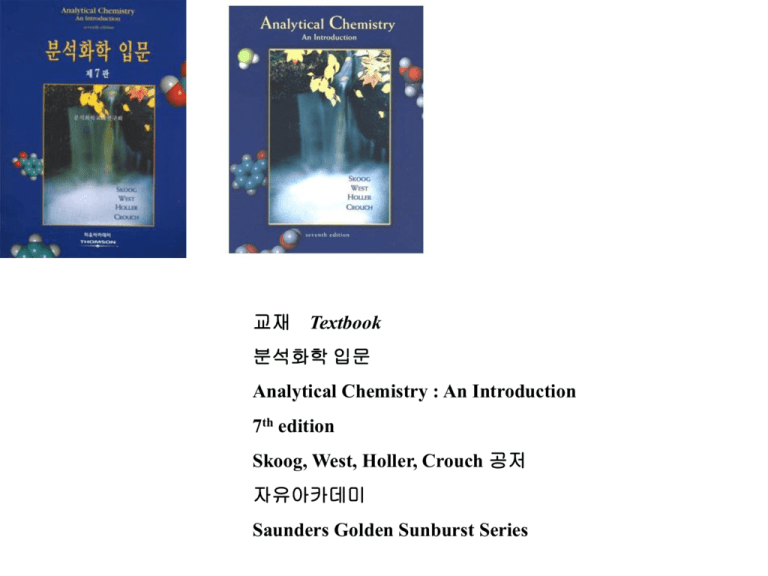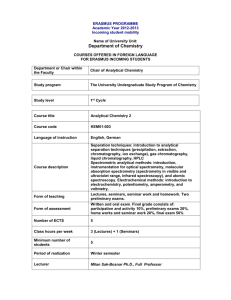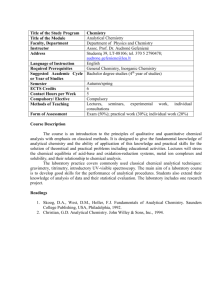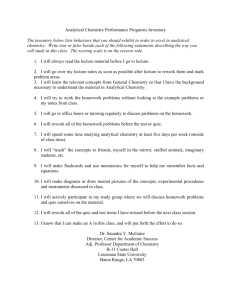
교재 Textbook
분석화학 입문
Analytical Chemistry : An Introduction
7th edition
Skoog, West, Holler, Crouch 공저
자유아카데미
Saunders Golden Sunburst Series
Reference Book
Quantitative Chemical Analysis
8th edition
By Daniel C. Harris
Hardcover / W H Freeman / © 2011
ISBN-10: 1-4292-1815-0
Fundamentals of Analytical Chemistry
8th Edition
Douglas A. Skoog - Stanford University
Donald M. West - San Jose State University
F. James Holler - University of Kentucky
Stanley R. Crouch - Michigan State University
ISBN 0-534-41797-3
992 pages Case Bound 8 X 10
http://mail.swu.ac.kr/~cat/
구글, 네이버, 다음
분석화학 강의노트
Version 2012 Spring
Updated on 022312
Copyright. © All rights reserved
Dong-Sun Lee, Prof., Ph.D. Chemistry, Seoul Women’s University
dslee@swu.ac.kr
http://mail.swu.ac.kr/~cat/
Version 2012 Updated on 022312 Copyright © All rights reserved
Dong-Sun Lee, Prof., Ph.D. Chemistry, Seoul Women’s Univ.
Chapter 1
What is Analytical Chemistry?
Introduction
What is chemistry ?
Structure
Reactions
Properties
Chemistry (kem'is tree): noun.
The science in which substances are
examined to find out what they are made
of, how they act under different
conditions, and how they are combined or
separated to/from other substances.
To paraphrase that, chemistry deals with
finding what different substances are made
of, what kind of transformations take place,
and different chemically related facts about
a certain organism or substance.
Introduction
Fields of chemistry
Physical chemistry
Analytical chemistry
Organic chemistry
Inorganic chemistry
Biological chemistry
What is Analytical Chemistry ?
- Analytical chemistry deals with separating, identifying, and quantifying the
relative amounts of the components of an analyte.
- Analyte = the thing to analyzed; the component(s) of a sample that are to be
determined.
What is analytical chemistry ?
- Qualitative analysis :
What is present ?
determination of chemical identity of the species in the sample.
- Quantitative analysis :
How much present ?
determination of the amount of species or analytes, in numerical terms. Hence, math is
heavily involved. In order to perform quantitative analysis, typically one needs to complete
qualitative analysis. One needs to know what it is and then select the means to determine the
amount.
- Instrumental analysis
The role of analytical chemistry: central science
The relationship between analytical chemistry and the other sciences
Chemistry :
Biological, Inorganic, Organic, Physical
Physics : Astrophysics, Astronomy, Biophysics
Biology :
Analytical
chemistry
Botany, Genetics, Microbiology, Molecular biology, Zoology
Geology : Geophysics, Geochemistry, Paleontology(화석학), Paleobiology(고생물학)
Environmental science : Ecology, Meteorology(기상학), Oceanography
Medicine : Clinical, Medicinal, Pharmacy, Toxicology
Material science : Metallurgy, Polymers, Solid state
Engineering : Civil, Chemical, Electronical, Mechanical
Agriculture : Agronomy, Animal, Crop, Food, Horticulture, Soil
Social Science : Archeology(고고학), Anthropology(인류학), Forensics
Several different areas of analytical chemistry:
1. Clinical analysis - blood, urine, feces, cellular fluids, etc., for use in
diagnosis.
2. Pharmaceutical analysis - establish the physical properties, toxicity,
metabolites, quality control, etc.
3. Environmental analysis - pollutants, soil and water analysis, pesticides.
4. Forensic analysis - analysis related to criminology; DNA finger printing,
finger print detection; blood analysis.
5. Industrial quality control - required by most companies to control
product quality.
6. Bioanalytical chemistry and analysis - detection and/or analysis of
biological components (i.e., proteins, DNA, RNA, carbohydrates, metabolites,
etc.).
This often overlaps many areas.
Develop new tools for basic and clinical research.
Classification of Quantitative Methods of Analysis
1) Gravimetric Method: mass is measured.
2) Volumetric Method: volume is measured or used to determine amount
of sample via concentration.
3) Instrumental Method: use an instrumental technique to assay the
amount of sample:
Such as: Electroanalytical based upon electron-transfer
Spectroscopy including mass spectrometry
Separation: GC, HPLC, CE
Classification of Quantitative Methods of Analysis
1) Gravimetric Method: mass is measured.
2) Volumetric Method: volume is measured or used to determine amount
of sample via concentration.
3) Instrumental Method: use an instrumental technique to assay the
amount of sample:
Such as: Electroanalytical based upon electron-transfer
Spectroscopy including mass spectrometry
Separation: GC, HPLC, CE
Miscellaneous analytical methods
1. Mass spectrometry - mass-to-charge ratio of an analyte's decomposition
products.
2. Radiochemical methods - measuring rates of radioactive decay by an
analyte.
3. Kinetics - measuring reaction rates.
4. Thermal conductivity.
5. Optical activity - measuring the interactions of an analyte with planepolarized light.
6. Refractometry / Refractive index.
Methods of Detecting Analytes
Physical means
mass
color
refractive index
thermal conductivity
with electromagnetic radiation (Spectroscopy)
absorption
emission
scattering
by an electric charge
electrochemistry
mass spectrometry
As you can see there are a limited number of ways to detect an analyte.
However, in each of the above general categories there are a large
multitude of specific analytical techniques.
Steps in a Typical Quantitative Analysis
1. Select a method: accuracy, reliability, time and cost, complexity of sample
e.g., blood samples, pharmaceutical products.
2. Sampling: obtaining “a representative sample”, especially important for mass
products.
3. Sample preparation and handling
a) Dissolution or digestion of samples
Avoiding decomposition conditions. This is especially troublesome for biological samples.
b) Preparation of solid samples :
Solids are usually ground to a suitable particulate size to get a homogeneous sample.
4. Define replicate sample: accuracy, reliability and cost
5. Eliminating interferences: blank control
6. Calibration and measurement
CA= kX
y = mX + b
7. Calculation and data reduction
8. Evaluating results and estimating their reliability
This requires appropriate use of statistics.
An analytical result without an estimate of reliability is of no value.
Specificity and Selectivity
Techniques or reactions that work for only one analyte are said to be specific.
Techniques or reactions that apply for only a few analytes are selective.
Matrix
The matrix or sample matrix is all of the components in the sample
containing an analyte.
What is analytical chemistry ?
<Result set> = {S, [Ci]1n, [Qi] 1n, [Ai] 1n, T}
where S = matrix system, Ci = species,
Ai = accuracy, T = time
Source : Philip Barker : Computers in analytical chemistry
Qi = quantity,
32
NL:
1.10E7
TIC MS
090505_000905
115830
Relative Abundance
100
Lavender
18
50
36
33
13
25
38
24
12
6
23
11 16 19 22
12 3 45 7 810
26
0
5
10
15
20
25
Retention time (min)
41
30
35
43
40
45
http://mail.swu.ac.kr/~cat/
Journals Related to Analytical Chemistry
5.874
3.841
3.289
4.310
4.194
3.913
3.722
3.236
2.631
1.53
2.846
2.009
0.920
9.023
0.871
Q
n
A
Thanks.
Dong-Sun Lee / 분석화학연구실 (CAT-Lab) / SWU.






